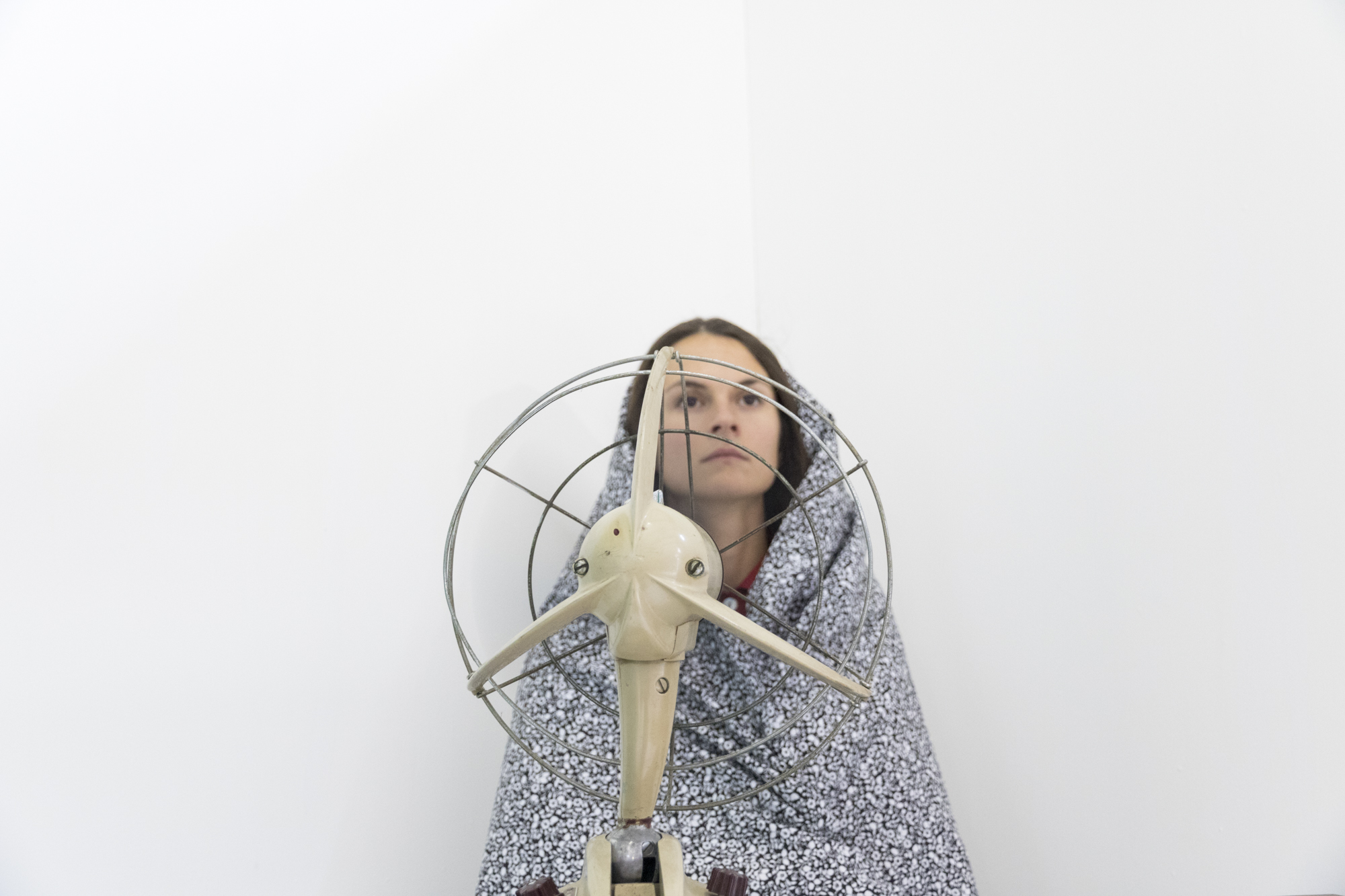“The tiniest bud shows us that in fact there is no death.” (Walt Whitman).
Nothing is more appropriate to introduce the research of Alice Mestriner (Treviso, 1994) and Ahad Moslemi (Teheran, 1983) aimed at the revelation of a sense and a meaning beyond any formalism. A world made up of elements as imperceptible as dust: “It is an apparent great void that contains everything” [Alice Mestriner – Ahad Moslemi], and the search for a human identity based on the possibilities of language and its meanings: “It is the linguistic act that creates a cultural identity.” [Alice Mestriner – Ahad Moslemi]
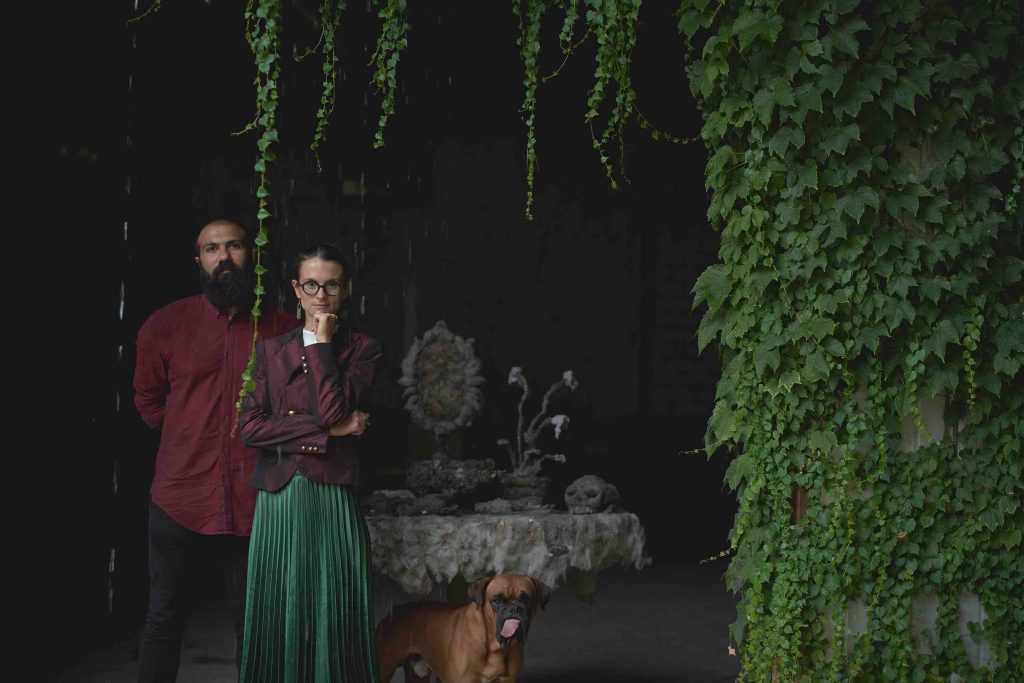
Elena Solito: How was your collaboration born? Who are Alice and Ahad?
Alice Mestriner/Ahad Moslemi: We met for the first time in Canada in 2016. Both foreigners in a very far land. How it came to be there, that’s the deal! One was looking for his freedom, another one was looking for her roots. (Ahad) I emigrated to Canada from Iran in 2011 and since that moment I have been living there. At that time, when I met Alice, I was doing my BA in Visual Art and carrying on my research on the field of identity. (Alice) Five years ago I felt the need to get close to my relatives from my father’s side, because most of them emigrated to Canada during the Second World War and they have been living there until now. With this pretext I applied for an internship in Québec, so life leads me to the same University where Ahad was studying. Our first project together was in 2018 in Italy at Villa Memo. Our purpose was to investigate the Villa’s history and identity. We spent a lot of time trying to collect and research upon all the traces that were present in that ambience, traces that suggest the past of the place itself. Digging in that past and place, we noticed that the more we were digging the more we were getting close to the present. In this very place the concept of dust has started.
E.S.: What does it mean to investigate the meaning of things beyond pure aesthetic formalism? I am referring specifically to what you state in your statement: the search for meaning and significance. What makes sense to you today?
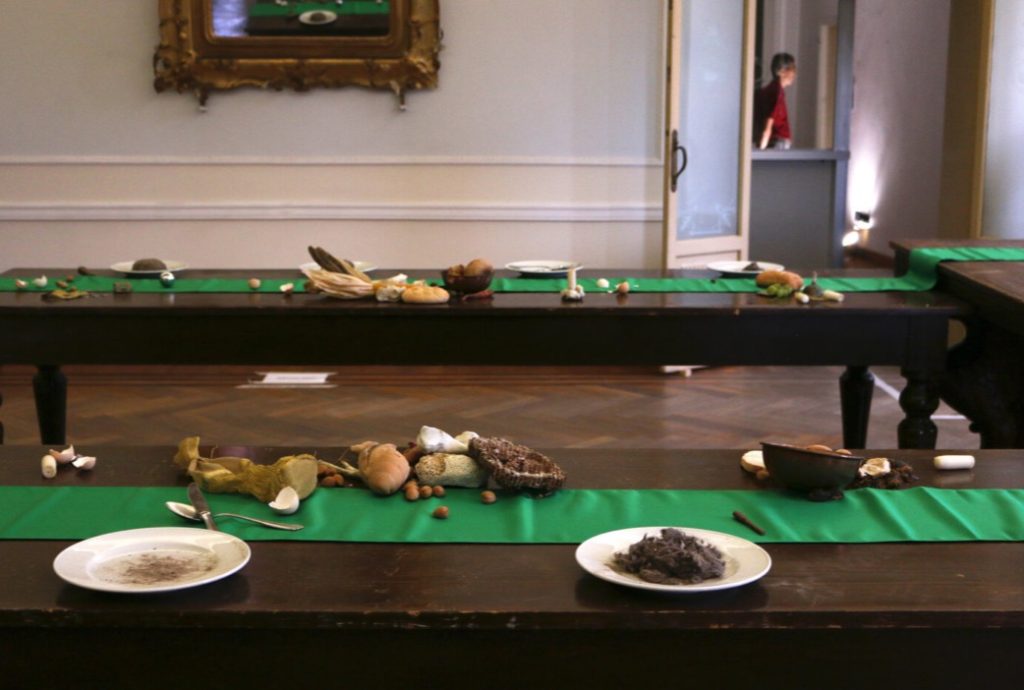
A.M./A.M.: The second one is such a good question, and it is exactly what we are trying to answer ourselves. Probably nothing or probably too many things make sense today, and we guess it is exactly in this making sense the knot of the problem.
Every area of knowledge tries to answer and the deal is exactly that all of them give answers which are all logical and probable. Well, exactly here we have started to wonder. “I beseech you, brothers, remain faithful to the earth and do not believe those who speak to you of superearthly hopes! They are poisoners, whether they know it or not. They are despisers of life, dying and poisoned themselves, of which the earth is tired: they go away!” Zarathustra said. Investigating the meaning of things beyond the pure aesthetic formalism means giving voice to all the forces and the invisible things that stay behind, constitute and originate the meaning of an object like archaeology. Most of the time a word already collects into itself a list of other meanings and (maybe) the form is just a result of a mental process. In this process time has got a crucial role. What we can state today is that it doesn’t matter which meaning we are talking about, all of them culminate in the same point: into the vanity. What fascinates us is the tension with which Man has been trying to fill this emptiness.
E.S.: Dust, time, identity and the table as a concept of community and collectivity, are recurring elements in your artistic practice.
A.M./A.M.: They are not directly connected with the concept of community and collectivity; all of them are collective objects that are somehow immersed in the same atmosphere, where dust is the main atmosphere in whom it is directly possible to experience Time and its effect. Dust is a milieu of temporal copresences, the ensemble of present, past and future. Laydown over these things’ identity develops and gives meaning to reality. Yes, it is true tables are recurrent in our practice. Tables are symbolic places, sometimes an expression of power, sometimes a place of decisions, a place of sharing and for us it is like a studio, a place of dialogue and conversation.
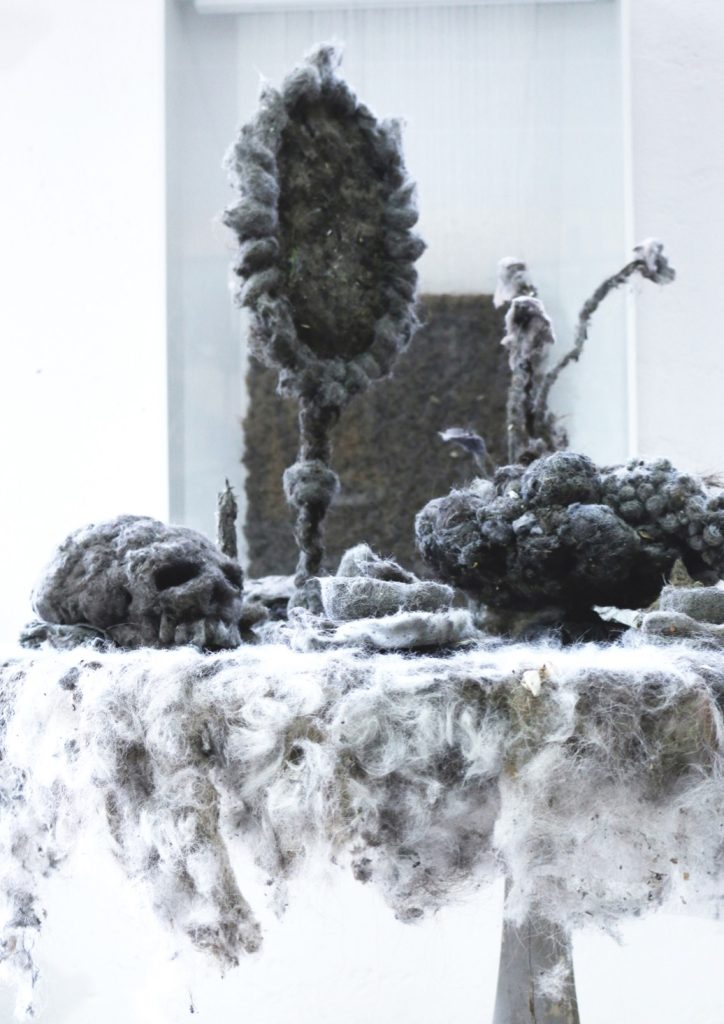
Photo Alice Mestriner / Ahad Moslemi
E.S.: On the occasion of the exhibition at Spazio Serra as part of the exhibition season whose theme was venerazioneMUTANTE you presented a site-specific work materiaprima centered on the theme of dust. Still the life and Albero a Gomiti (both from 2020) are a kind of mapping of society through dust, an organic element that becomes materic in your work.
A.M./A.M.: Dust is a commonplace, a collective name. In fact, dust is not dust but a group of elements. Dust is the world’s extension. Dust is like a dictionary accompanied by a crazed grammar book. It is a dictionary in which the signifier is identified but whose meaning has been lost or is about to be lost. When it is-about-to- be-lost has the opportunity to show the traces of what he has been and, in any case it carries with it the symptoms of his future. The return to the fragment, to the point, to the atom, to nothing. Dust is an Arupian language [from Hopi’s language], it has the ability to reform the shapeless and to regenerate its new forms. By crossing other fragments, it recreates new forms. Many spelling errors can occur within dust, but it is from the error that a new phase is born, new meeting and a new evolution / transformation. Dust is this and has the characteristic of what we love to define the aesthetics of immortality, the exact reflection of the contemporary’s dream. There is nothing more complete than dust, it is not only an object but also a subject. Dust is a highly identifying material; dust contains skin, hair, dander, food residues, fabric, insects, microbes, vegetal and non-vegetal elements, it contains terrestrial but also extra-terrestrial materials because it contains micro fragments of stars and meteorites. For this reason, we call it a living and open system. It is an apparent great void that contains everything.
E.S.: In Futuro Anteriore a table represents a still life that comes to life through matter and time. Also in Abitudini Ripetitive (2019) you propose a sort of last supper.
A.M./A.M.: Good point! Yes, they are somehow opposed and complementary, although they are rooted in a common ground: language. Both works talk about language and its particular and peculiar characteristic: being more than itself and what it expresses, and last but not least the possibility to be interpreted. Surely, we are at the beginning of this research that’s why we decided to approach the subject touching just its ‘surface’ and in Futuro Anteriore we wanted to make a parallelism between the tense: Futuro anteriore and this materiality, the dust. From our point of view dust is the embodiment of this tense. It is exactly the personification of it. This tense is a tense of the indicative that expresses facts projected into the future, but which occurred before others like in a still life, this still life. The plasticity of the objects is shown to our eyes, it is formed and tangible but their translation in a form within this material which is dust makes a short-circuit and it turns into Futuro Anteriore, a future state before something else to happen or to become. A temporal synaesthesia reflected and condensed in a materiality, in a common ground. Abitudini repetitive is focused on the possible misleading directions that language could have and into which it could direct us. We reflected on Giuda’s position in Christian culture and wondered how it could have been different if its position was used in another direction and this very context has been created by language and its powerful acts.
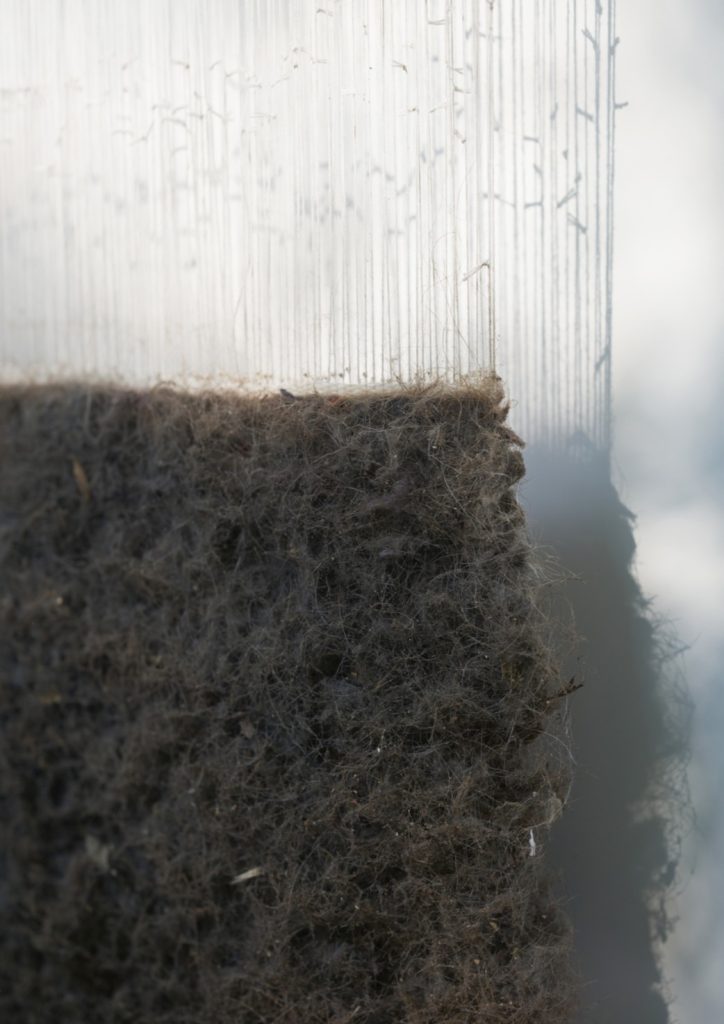
Photo Giulio Favotto
E.S.: From an anthropological point of view, the table represents a moment of sharing within a community, rich in symbolism. Are we still sure that contemporary society is willing to share in a historical moment in which walls are raised, there are deep ideological, religious and social divisions?
A.M./A.M.: Our answer in concrete facts is us. The problem is that it could become true what you are questioning but where is this point rooted? The roots of the problem are located exactly in a very weird tool, the language itself. People are not the governments, people are ‘’people’’, shaped but people. Sure, we wrote it in quotes because we all breathe the atmosphere of our country and its systems of power, but we still see that there is also an opposition between individuals and governments. Of course, through the use and the power of language they direct us, oppress us, manipulate and try to get under our skin and into our private sphere we cannot deny so and all media works on it. We would rather direct the focus on who builds these walls, why and in which way they build it. For sure there is no ideology behind wars, there is no religion behind it, there is just power, economic interest and money. Ideology and religion are just fashionable dresses, to build a pretty landscape, a pretext and a ‘justification’ to turn on conflicts, to push people to run into war, to play with people’s feelings and cultural identity and trust.
Any country, (from the governmental perspective), needs and has to have a common cement to unify people. People today, due to the easier possibility to have access to information and news, have started to have more conscience and knowledge. Maybe we cannot do anything effective to fight against this, but this conscience is a remarkable symptom. We are not stating these things do not exist, on the contrary they do exist, but we are putting the focus where they were born, within language, and how this weapon is effective on our behaviour, actions and thoughts. There are actions that are perpetuated and have been perpetuated over time, but these repetitive habits are changing, and we see all the evidence, because of that, due to this silent rebellion oppression is getting stronger. We found ourselves in different countries and contexts where we could experience this. In Mexico, in Turkey, in Iran. People are not their governments, and yes, they still have got the will to share, maybe even more than before.
Online platforms -also- show us the will to share, see and discover otherness, in particular where it is not fiscally or politically possible. Are ideologies, religions and social divisions present in nature as natural objects? We haven’t found yet an ideology laying down on the ground catching the sun, sitting on a bench or walking on the street. Rather we found them embodied on the ground, embodied on the city and embodied on the city. And where does this embodiment come from? The highway into which this embodiment developed is the language and through it. SO, not a natural embodiment but an artificial embodiment that became possible through an artificial tool. The language. We do not build walls; politics with language build walls and confines. These are not natural phenomena; these are the manifestation of an embodied thought which is always a political manifestation.
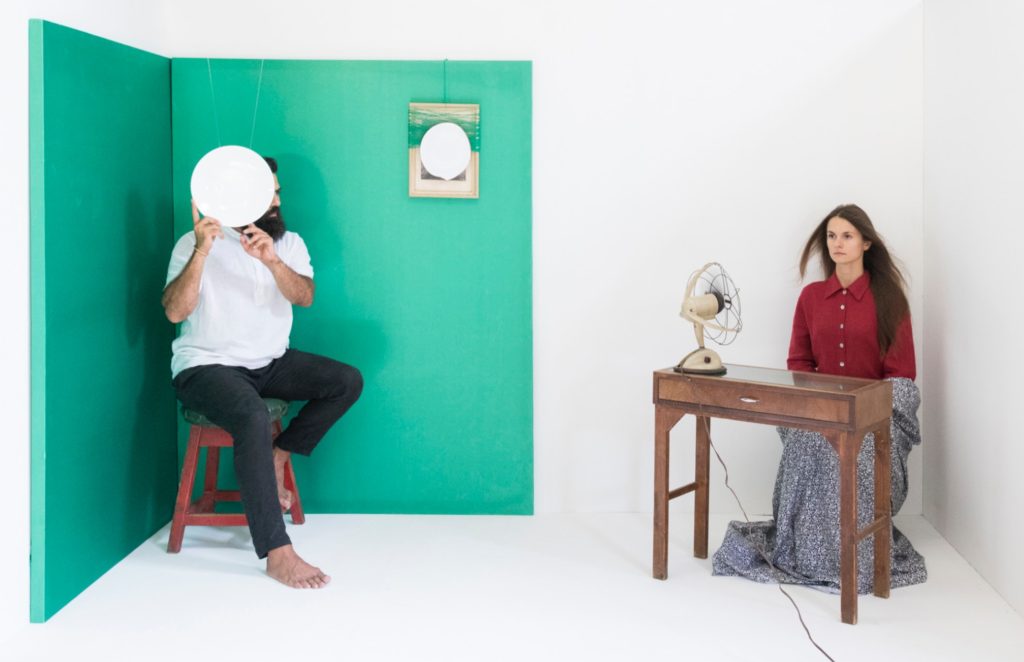
E.S.: In several of your works, language becomes the focus of your research. The linguistic act characterized identity, culture and society. I think of Nuova Grammatica (2020) or We are I.
A.M./A.M.: New Grammar is a white linen canvas with a white sewn upon. Plastically speaking it appears as a natural fabric with an artificial action which shows a statement which proposes new tenses belonging to a new language. The images of the words, -images related to words- are mutable beings while language is a tool which petrifies the becoming, because it defines things. Giving a define meaning and shape to concepts, images of the world and forms. Language is an abstract structure which speaks about tangible and concrete things that are inevitably affected by the stream of time. Language is a battleground that makes clashes due to its main proprieties: being a common tool, a medium of sharing, based on personal images of the world, referred to personal experiences of a specific meaning. When it is considered as a mere and common tool of communication we focus on its apparent and illusory ability to define things and the reality itself. It is actually illusory because language is not a positive element of nature, part of it (intrinsic) but it is an arbitrary convention created by man upon -others- linguistics convention. Due to this perspective that sees separation between language and the natural world, we observe that something strange happens. World by definition is not a stable and immutable being, on the contrary it is the manifestation of its materiality’s mutation. So, how can we think to speak precisely about the world with a tool exactly created to share stable and defined concepts and meanings about the world that is the realm of mutation? Well, they are not overlapping. Because of that we have been starting to wonder about the language’s structure and seeing that maybe there is something wrong with it. The language with a precise structure kills the becoming because it defines living and mutable things. It is a paradox that defines what is alive. Matter is alive and constantly ongoing as we can see into dust. In this way the becoming loses its meaning.
So, to Live means to become but if we are, we will not be. With this canvas we tried to formulate a new language’s structure that will not kill: Speaking of the past: “I AM” – because it is past and I was someone I am not now, so a fixed image and meaning, past is defined. Speaking of the present: “ — ” – moment of formation, no way to communicate this process of creation. Speaking of the future: “WANT’’ – aspiration, will, tension to a definition, towards a form. On the other hand, with the project We are we tried to show how the influence of language on people’s perception could be subtle and sharpened. This work reflects on the consequences of the sense of belonging created through language games. This phrase is the sense of solidarity used by all the systems of power aimed to create empathy between people, holding them together in a bubble of positive feelings and not, thus creating cultural identity but also a misleading individual identity. This is the atmosphere in which the individual identifies himself, without recognizing himself.
We are is the concept used by politicians to create a cultural and social context. We are is the act, the linguistic act, they use to lead people into a specific direction; where people take part of a group and they feel part of the same without no choice. Being part of a group means to be surrounded by a sensation of togetherness which pushes away the sensation of loneliness. This togetherness’ feeling creates a specific dynamic. We are is the thin, sharp, silent strength that puts everything together, in a positive way and in a negative one. We are is not always a common place, and in this case, we rediscover the dimension of the I.
We are is a minimal but incisive sentence. It’s the union of a subject and its verb. It’s the action. We are the formula, the concept used by power systems to create a cultural and social context. We are the act, a linguistic act, which is used to lead people in a specific direction, making them feel part of a group with no choice, living within a linguistic act full of meaning that is not decided by them. Being part of a group means being surrounded by a feeling of solidarity that drives away loneliness. This feeling that comes from the phrase –We are- inevitably creates a dynamic, a collective and a union. We are the subtle meaning, the sharp and silent force that brings everything together, in a positive and negative way. But We are not always a cliché and are not always really approved by the whole community. In this case the group rediscovers the size of the ego. And then: -I am not-. We are the difference between political acts and people. It is the linguistic act that creates a cultural identity. It does not matter if it is false, distorted or misrepresented. The focus is here: We are the instrument of power and control.

Di-monologue, 2018 Performance
Photo Teresa Masini

Di-monologue, 2018 Performance
Photo Teresa Masini

Di-monologue, 2018 Performance
Photo Teresa Masini
E.S.: Expanding on the previous question, what do you think of the use of language in contemporary society, of the linguistic debasement taking place.
A.M./A.M.: We are not pretty sure that we are attending to a linguistic debasement if we consider all the capacity language carries within itself. It just came to our mind when Umberto Eco was talking about language saying that it has been transformed into a heavy industry! Well, can we deny it? I mean within this word there exists a myriad of different declinations and facets of it, one of them is exactly the visual universe. There are not just words. Can we include into this debasement the visual culture and speaking of debasement also for it? Language is not language, and when we mean language, we mean the whole category included in it, its structure, its organization and way of acting and making sense.
On the contrary there is for sure a proliferation of languages and maybe a debasement of our capacity of reading them. The debasement is on our understanding but not for sure in language itself. Exactly in this direction and because of this Umberto Eco said that the semiotic is the only valid and possible way of philosophy today. We are disoriented within language and due to this reason, we have the Impression not to understand or to understand in a blurry way. All the manifestations of sense are significant and full of debris and resides of a history that comes from faraway, and which Is getting melted and mixed with new spheres of meaning. Even the void and the most insignificant sign is charged by its past bringing its atmosphere and archaeology. In Baudrillard’s simulacry there is more than something we can apply to language and see how farther they are getting through reality.

Alice Mestriner and Ahad Moslemi
What an image is not, 2016 Val de Bravo Messico

Alice Mestriner and Ahad Moslemi
What an image is not, 2016 Val de Bravo Messico
E.S.: What are you working on? What plans do you have for the future?
A.M./A.M.: Right now, we are working on different things. We are attending a residency with the organization Iodeposito in Friuli Venezia Giulia, as the organizer Chiara Isadora Artico wrote: “it is a project that aims to deconstruct, rework and re-build in a collective key, and represent – through the physical body and the body of a work of art – the memory of the territories of the extreme north-eastern border (the Julian Alps and the Karst, the Udine foothills and the Isonzo), elaborating the theme of absence and industrial divestment”. Then we are trying to get in contact with some international institution to realize a project that started with a course with Antoni Muntadas. The project was born from the discovery of a diary; when we opened and read it we found it particularly unitary in its content. The diary is dated 1957-1958, on the back there is a dedication that introduces what awaits us in its entirety: Venice-Europe. The pages narrate two years of life of a Venetian aristocratic lady who frequents the company of her peers; she goes from person to person and from city to city chasing a man who seems to have given a negative answer to her love for her. So, she starts chasing her by heading towards Velden and gradually she will find herself at the Arctic Circle, in Svalbard. These are the two mains.


